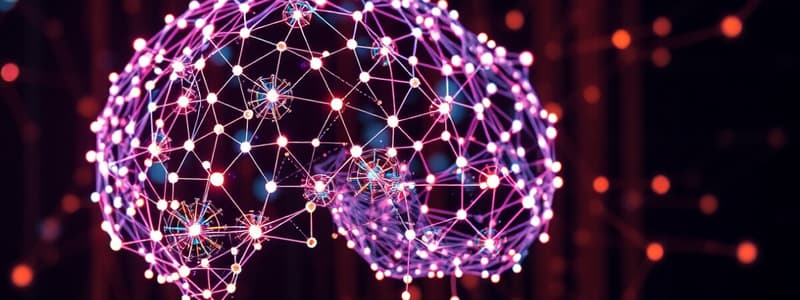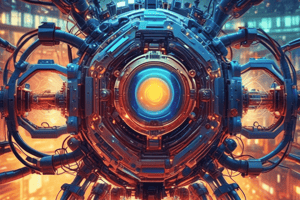Podcast
Questions and Answers
What benefit does an Artificial Neural Network (ANN) have in terms of its learning process?
What benefit does an Artificial Neural Network (ANN) have in terms of its learning process?
- It continuously learns on the job, improving over time. (correct)
- It can only analyze structured data effectively.
- It excels in linear relationships without adjustments.
- It requires extensive manual programming for each task.
In which scenario is an ANN particularly beneficial?
In which scenario is an ANN particularly beneficial?
- When the model is expected to remain static and not change.
- When manual adjustments are preferable over automated learning.
- When dealing with high volumes of complex data that evolves over time. (correct)
- When data is limited and simple functions are used.
What is a significant characteristic of IBM Watson's natural language understanding capabilities?
What is a significant characteristic of IBM Watson's natural language understanding capabilities?
- It does not leverage transfer learning for different contexts.
- It requires specialized programming for each industry.
- It primarily functions with structured data only.
- It utilizes a three-layer model to enhance understanding. (correct)
What role does noise reduction play in the application of ANN?
What role does noise reduction play in the application of ANN?
What is a crucial step in the development of an ANN?
What is a crucial step in the development of an ANN?
Why might an ANN be preferred over human experts in certain predictive tasks?
Why might an ANN be preferred over human experts in certain predictive tasks?
What is one of the advantages of using Artificial Neural Networks?
What is one of the advantages of using Artificial Neural Networks?
Which of the following describes an application of ANN in the finance sector?
Which of the following describes an application of ANN in the finance sector?
During the training phase of an ANN, what is the purpose of training data?
During the training phase of an ANN, what is the purpose of training data?
What does the term 'transfer learning' refer to in the context of IBM Watson?
What does the term 'transfer learning' refer to in the context of IBM Watson?
What is the primary function of a neuron in an Artificial Neural Network?
What is the primary function of a neuron in an Artificial Neural Network?
Which activation function is most commonly used in Artificial Neural Networks?
Which activation function is most commonly used in Artificial Neural Networks?
What learning method is primarily used to adjust weights in an ANN?
What learning method is primarily used to adjust weights in an ANN?
Which aspect of ANNs allows them to learn and generalize effectively?
Which aspect of ANNs allows them to learn and generalize effectively?
Which of the following statements best describes the architecture of a popular ANN?
Which of the following statements best describes the architecture of a popular ANN?
What is the role of the sigmoid function in an ANN?
What is the role of the sigmoid function in an ANN?
What advantage does IBM Watson leverage in its operations?
What advantage does IBM Watson leverage in its operations?
What is the initial phase in the functioning of an ANN?
What is the initial phase in the functioning of an ANN?
What process is used in training a neural network to enhance its learning?
What process is used in training a neural network to enhance its learning?
Which characteristic makes backpropagation essential for ANNs?
Which characteristic makes backpropagation essential for ANNs?
Flashcards
Artificial Neural Network (ANN)
Artificial Neural Network (ANN)
A simplified model of the brain, composed of interconnected neurons, that learns to transform inputs into outputs.
Neuron
Neuron
The basic processing unit in an ANN, performing calculations on input signals.
Forward Propagation
Forward Propagation
The process of data flowing through the network from input to output layers, without feedback loops.
Backward Propagation
Backward Propagation
Signup and view all the flashcards
Training Data
Training Data
Signup and view all the flashcards
Activation Function
Activation Function
Signup and view all the flashcards
Weights
Weights
Signup and view all the flashcards
Test Data
Test Data
Signup and view all the flashcards
Network Architecture
Network Architecture
Signup and view all the flashcards
Backpropagation
Backpropagation
Signup and view all the flashcards
Deep Learning
Deep Learning
Signup and view all the flashcards
Algorithm
Algorithm
Signup and view all the flashcards
Validation Data
Validation Data
Signup and view all the flashcards
IBM Watson
IBM Watson
Signup and view all the flashcards
Classification (ANN)
Classification (ANN)
Signup and view all the flashcards
Feed-forward Multi-Layer Perceptron
Feed-forward Multi-Layer Perceptron
Signup and view all the flashcards
Noise Reduction (ANN)
Noise Reduction (ANN)
Signup and view all the flashcards
Prediction (ANN)
Prediction (ANN)
Signup and view all the flashcards
Unstructured Data
Unstructured Data
Signup and view all the flashcards
Study Notes
Artificial Neural Networks (ANNs)
- ANNs are simplified models of the brain
- A neuron is the basic processing unit
- Neurons transform inputs to outputs
- ANNs consist of many neurons performing desired functions
- Connected with weighted connections
- ANNs learn and generalize on their own.
- ANNs are used in various applications
Learning Objectives
- Describe ANNs
- Understand ANN business applications
- Understand how ANNs work conceptually
- Understand IBM Watson
- Explain advantages and disadvantages of ANNs
What is an ANN?
- Extremely simplified model of the brain
- Neuron is the basic processing unit of the network
- Input data is transformed into output data optimally
- Composed of many performing neurons
- Many weighted connections between neurons
- Learn and perform tasks on their own
- Strong ability to learn and generalize
The Perceptron
- A simplified neuron model with inputs, weights, and an output
- Weights multiply inputs
- Inputs are summed, and a function (activation function) is applied to determine the final output
Design Principles
- Forward Propagation: Input signals flow forward through the network, layer by layer, to produce an output
- Backward Propagation: Error signals are backpropagated through the network to adjust the weights to improve the output.
How ANNs Work
- Output is a function of the weighted sum of inputs plus a bias
- Activation function is applied to the input
- Common activation function is the sigmoid function (smooth, continuous, monotonically increasing)
- Weights are very important in determining the function
- Weights adjusted by a method called backpropagation
- NN trains by adjusting weights based on feedback from previous decisions
Architecting a Neural Network
- Various architectures possible, each with flexibility
- Feedforward, multi-layered perceptron with back-propagation algorithms are the most popular
Case Study: IBM Watson
- AI platform for businesses using machine learning
- Sophisticated machine learning technique (Deep Learning)
- Improves quality and accuracy of results
- Handles unstructured data (video, audio, images)
- Examples include comparing damaged car images, natural language understanding for different industries, and three level models (basic, industry specific, company specific)
Business Applications of ANNs
- Used with numerous data and complex objective functions expected to improve over time
- Classification
- Pattern recognition, feature extraction
- Approving financial loan applications
- Noise reduction (ex. airline pilot voice and engine noise)
- Prediction and Extrapolation (ex. stock price predictions)
ANN Training to Learn
- Accuracy of ANN predictions improves over a long period of time with large training data sets
- Can become more accurate than human experts
- Deployment in real-time situations is a possibility
Developing an ANN
- Gather training and test data
- Choose network architecture (e.g., Feedforward)
- Select an algorithm (e.g., Multi-layer Perception)
- Set parameters
- Train with training data
- Validate with validation data
- Freeze weights/parameters
- Test with test data
- Deploy if accuracy is good
Advantages of ANNs
- Little restriction on use
- Deal with non-linear relationships
- Learn from examples without significant programming
- Handle various problem types (classification, clustering)
- Tolerant to data quality issues without strict assumptions
- Handle numerical and categorical variables
- Faster than other techniques
- Provide better than statistical counterparts (once trained sufficiently)
Disadvantages of ANNs
- "Black box" solutions; difficult to understand how results are reached
- Optimal design still an art; requires expertise and testing
- Can be difficult to handle large numbers of variables
- Requires large datasets for effective training
Studying That Suits You
Use AI to generate personalized quizzes and flashcards to suit your learning preferences.




